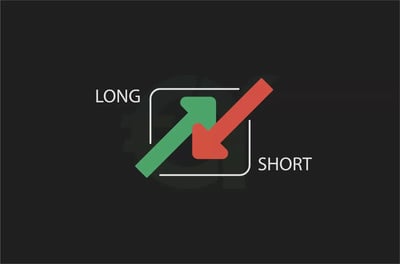Long Vs. Short Crypto Trading Explained
It's not uncommon for me to notice that certain terms confuse new traders more than others. Many traders will have heard terms like “Going long on a trade,” or “Going short on an asset.” What does it all mean? In trading terms, going long is when you buy an asset with the intention of holding it to sell at a higher price later. Going short involves borrowing an asset from a broker, selling it at current price, with the intention of buying it again at a lower price, and returning the asset to the broker. I understand that shorting, in particular, is confusing, which is why I will explain it in detail later.
In time, you will learn how to use these terms seamlessly and interchangeably. In this brief article, I will delve into more depth about the differences between long and short positions, while telling you which is best suited to which situation.
Going long means buying a cryptocurrency expecting its price to rise, while going short means selling borrowed crypto expecting its price to fall.
Long trades are common during bull markets and are favored by traders who expect assets to gain steadily over time.
Shorting is riskier but can be profitable during bear markets if traders correctly predict a drop and time their trades with precision.
Long-term investors often go long by buying dips and holding assets for months or years based on macro trends and faith in crypto’s growth.
Short trades involve borrowing coins from a broker selling them at the current price and buying them back cheaper to return to the broker.
Before going long or short, you should rely on solid technical and fundamental analysis, including resistance and support levels.
Margin trading and leverage can amplify both profits and losses when taking long or short positions in crypto markets.
Successful trading in either direction depends on research timing and understanding that markets can shift quickly and unexpectedly.

What Are Short and Long Positions?
Long and short positions are two ways in which you can enter a trade with the intention of making a profit. As I have mentioned, traders who go long are anticipating the price to rise from a certain point. Traders who go short expect the price to decline from the entry price.
In cryptocurrency terms, going long is the act of investing in crypto with the intention of holding on to it until the price rises, at which point you will sell it for a profit. Generally, if you adopt a long position, you are known as a bull trader because you go long more often than short. This is because you like to take advantage of bull (rapidly appreciating) markets.
In crypto markets, nearly everyone has been a bull trader, as the market has been on an upswing longer than it has been on a downswing. Naturally, as a volatile instrument, crypto inevitably slows down and becomes bearish (rapidly losing value). Bitcoin's all-time high, at the time of writing, was $104,000, but just two years earlier, the value of the coin was $17,000. We've written an article about the best crypto trading strategies during a bear market.
Going short, by contrast to going long, is adopting a position that seeks to profit from an expected market decline. In essence, you are betting against the market. It is a pessimistic view of the market’s short-term outlook, but of course, it is informed by technical analysis and accurate gauging of market sentiment. Shorting is not an indictment on any market’s performance, it is simply about traders recognizing the fact that all markets lose and gain value over time, and they would like to take advantage of an impending loss of value. Through technical analysis methods like charts and Japanese candlesticks, traders can near enough predict when markets will fall.
In case you were wondering, traders can combine long and short trades to hedge against each other to better manage their risk. These types of hedging activities are commonplace in the market. There is a stereotype that bull traders favor aggressive and risky trading, while bear traders are more conservative. These are generalizations that tend to be incorrect, as traders can easily employ short and long trades and frequently do, as the market requires. For crypto traders, it is worth noting that some crypto exchanges offer trading on margin, which can multiply the profits or losses of long and short positions.
Recommended Brokers
Long Trades Explained
I've come to understand the dynamics between long and short trading as my trading career has progressed. If you are trading crypto and you enter a long trade, you have purchased some coin, and you are waiting to sell your coin when the price rises. Remember that day traders use the terms “buy” and “long” interchangeably. When you hear traders say they are “Going long on Ethereum,” it simply means they are buying Ethereum. Likewise, trading software features a trade entry button marked “buy,” while others have buttons marked “long.”
When you enter a long position, the potential to make a profit is vast. This is because the price of the asset could rise indefinitely. However, keep in mind that you will only realize all this profit if you are a swing trader or a position trader who intends to stay in the asset for an extended period. If you are a day trader, then, naturally, your plan to sell by the end of a trading day places a cap on your earning potential. In bullish markets, traders would want to go as long as possible. The idea is simple: a bear market is when an asset is on a run of growth, so buying or going long is a good ploy.
Considerations Before Taking a Long Position
In my view, before you enter a long position, you must always be sure you are using reliable market analysis. In technical terms, you would be waiting for the price to break above a certain resistance level and go on a long rally of growth. You hope the growth continues due to the conditions you have studied.
Going long for extended periods is a strategy employed by well-capitalized investors who have the means to hold the cryptocurrency indefinitely. They may have no intention of trading actively, but they will hold their coin for months and years, ignoring market dips and peaks, with the view that the asset will increase in value regardless of short-term setbacks.
This method is best adopted by wealthy traders who can afford to “buy the dip and sell the rip,” as they say, meaning they are happy to go long when the price is dropping, and other investors are divesting. Day traders, by contrast to long-term position traders, choose to complete their trades within a single day, but this is not to say they are not going long. They are going long, even if it is just for one trading session.
Always remember that the crypto market is still developing and is not mature when compared to other markets like FOREX, stocks, and commodities. Your technical analysis may tell you one thing, but you may have to test different strategies to navigate a market as immature and sometimes unpredictable as crypto. Just remember to understand the trading psychology you and every other trader are inclined to operate with.
Short Trades Explained
The language around shorting can be confusing to those who are not used to the terminology. This stems from the fact that it is normal for you to own something before you can sell it. Usually, possession and ownership mean you can dispose of the asset whenever you are ready. Shorting disrupts this normal chain. With shorting, you can sell the asset before you even own it.
How does this work? The process of shorting involves asking your broker to find some coin that you “borrow,” under the agreement that you will return the same amount of coin later. Remember, the broker wishes to receive the coin they loaned you, not the monetary value of the coin. So, if the broker loaned you 10 coins (incidentally, worth $100), then they expect to receive 10 coins back. As a short trader, you anticipate that the value of the coin will depreciate. By shorting the coin, you have borrowed 10 coins from your broker for $100, with the intention of selling those 10 coins for $100 to another trader. You now have $100 in your trading account, but no coin. However, when the coin depreciates to $70, as you predicted, you enter the market and quickly buy 10 coins (worth $70 at the depreciated value). You are now able to return the 10 coins to the broker, while making a $30 profit in your account.
Considerations Before Opening a Short Position
I would always remind new traders that shorting, as you can probably tell, is highly risky. It is always a good idea to rely on both technical and fundamental analysis before you decide to go short. Some traders prefer to go short when the price of a cryptocurrency breaks below a reliable support level. This means that you should have been watching the crypto for a while and you should be reliably informed of the likelihood of a fall in value.
Be sure that your research is trustworthy before you start. Shorting across the financial sector is popular among professional traders, who seek to learn how to succeed in this complex form of trading. In the stock market, the Securities and Exchange Commission (SEC) has issued rules, such as limiting stock sales when an asset declines by more than 10%. This is because short selling can drive the price of an asset into the ground. In the interests of preserving the stock and the market, shorting is monitored. As there is no such legislation in the crypto space, we can still see rampant shorting of cryptocurrencies once they begin to devalue.
The Bottom Line
I recommend that whether you go short or long depends on crypto and its price action when you are trading. Many traders do not worry about whether an asset is going up or down, they simply want to know there is movement, as this means they can profit from going long or short. Before you take either position, be sure that your research is sound and that you understand the risks. If you do this, there is no reason you cannot make good profit when the market moves in either direction.
FAQ
Yes. You can short cryptocurrencies. You can do this in several ways, including using a crypto margin trading platform or a crypto futures market to short crypto.
You should go long or use a long trade on an asset that you believe will rise in price. You should go short on a trade if you know the price will decline. Whether you go long or short depends on the amount of risk you can take on, and your trading strategy and preferences.
Yes. Traders can go long and short in all markets. It is part of the very nature of trading to make informed speculation on how the market will behave. Long and short positions are the essence of trading, and traders try to make sense of developing trends to make the right decisions.






